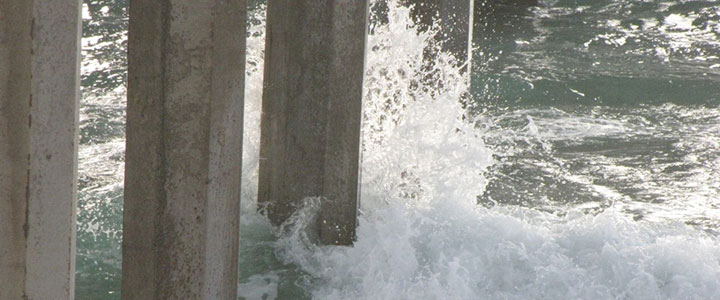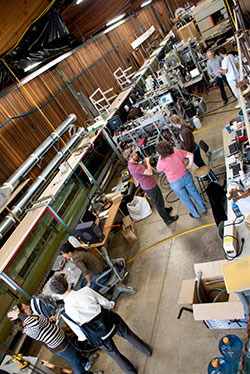
Center to Study Impact of Atmospheric Particles from the Sea on Climate Awarded $20 Million by NSF
By:
- Susan Brown
Published Date
By:
- Susan Brown
Share This:
Article Content

An innovative program of research and education addressing how interactions between air and sea influence the chemistry of the atmosphere will receive $20 million over the next five years from the National Science Foundation (NSF). The Center for Aerosol Impacts on Climate and the Environment, led by the University of California, San Diego, leverages the expertise of top scientists from nine universities to understand how particles released from the ocean influence the environment – from local water supplies to global climate.
“At UC San Diego, we tackle complex, pressing societal issues that have global impact. With this new award, we will build on our legacy of excellence in climate research and atmospheric chemistry that began with our founder, Roger Revelle, who helped bring the world’s attention to global warming,” said UC San Diego Chancellor Pradeep K. Khosla. “This funding – which highlights the talent and ability of our faculty to establish innovative, collaborative teams – will allow us to advance our understanding of how aerosols impact our climate and environment, and educate future scientists.”
The center focuses on one of the largest uncertainties in understanding and modeling climate: the role played by tiny particles called aerosols. The chemical complexity of these microscopic bits of salt, carbonaceous compounds, biological molecules and even microorganisms complicates efforts to understand how they influence atmospheric chemistry and physical properties such as warming.

CAICE researchers surround a 33-meter (108-foot) wave tank located in the Hydraulics Laboratory at Scripps Institution of Oceanography. The wave tank creates a closed environment that enables researchers to control studies of air-sea interactions and of aerosol formation and evolution.
“One of the primary innovations of CAICE is the development of new theoretical and technological tools that will provide a better fundamental understanding of realistic atmospheric aerosols in a laboratory setting where studies of their transformations and climate properties can be carefully controlled and measured,” said Kimberly Prather, Distinguished Chair in Atmospheric Chemistry at UC San Diego and director of CAICE. “This will ultimately allow more accurate predictions to be made about their reactivity and therefore influence on the atmosphere and climate.”
Ocean in a bottle
The ever-changing nature of the ocean in its wild state, with variations in temperature, wind, water chemistry and the life within it, makes measurements difficult and controlled experiments nearly impossible. To get around this, the team has captured the complexity of interactions between ocean and atmosphere by creating a microcosm of this dynamic system in the laboratory.
State-of-the art instruments arrayed along a 33-meter-long flume filled with water piped directly from the Pacific Ocean precisely measure the chemical properties of sea spray generated by breaking waves. This innovative approach offers advantages over others that approximate natural systems with simple chemical mixtures, yet still allows researchers the advantages of controlled manipulation of a complex system. Both seawater and the air above, enclosed by a dome, can be modified and measured, allowing the researchers to isolate individual factors to determine their influence on the chemistry of aerosols, and therefore climate.
“With this major new funding, we can now add human influences to our system – by spiking it with pollutants, changing the temperature, or increasing carbon dioxide levels, as examples,” said Prather, who holds appointments in UC San Diego’s department of chemistry and biochemistry and Scripps Institution of Oceanography.
CAICE, one of NSF’s Centers for Chemical Innovation, is the seventh center since 2007 to be chosen for Phase II funding. The program supports agile collaborations that can respond rapidly to emerging opportunities to address fundamental chemical challenges.
“Studying sea spray aerosols at a molecular level and understanding the complexity of the chemistry occurring on the surfaces of aerosols and bubbles in seawater is an example of the fundamental research NSF supports,” said Jackie Gervay-Hague, director of NSF’s chemistry division within the Directorate of Mathematical and Physical Sciences. “Fundamental research is absolutely essential to making important scientific discoveries and answering today’s most pressing scientific questions. In this case, this award supports an interdisciplinary team of scientists who will be able to continue to address important and challenging climate issues.” The center will be eligible to considered for an additional $20 million in funding in 2018.
“The expertise and international connections of the atmospheric chemists here at UC San Diego are perfectly suited to establishing broad and innovative collaborations, like the one we are celebrating today,” said Mark Thiemens, dean of the Division of Physical Sciences and Chancellor’s Associates Chair. “The combined and varied capabilities of the scientists that CAICE assembles is just what we need to understand the complex contributions of aerosols to global climate.”

Breaking waves inside a wave tank that houses a replica ocean-atmosphere system for a CAICE lab experiment. The mechanically generated waves simulate in a controlled setting ocean processes that eject aerosols into the atmosphere.
"This cross-campus center is another affirmation that UC San Diego is a world leader in the study of aerosols, which present one of the biggest challenges to the understanding and prediction of climate change, and in the study of their complex chemistry," said Cathy Constable, interim director of UC San Diego's Scripps Institution of Oceanography. “UC San Diego's emphasis on interdisciplinary study will greatly benefit the center as it seeks to understand a force with subtle but very wide-ranging effects on society.”
Impact on society, future
This creative collaboration will enhance our understanding of how aerosols absorb and reflect sunlight, seed clouds and influence precipitation, information that will improve our ability to predict regional climate and manage water resources.
In addition to these fundamental scientific discoveries, the center will also play a critical role in educating the next generation of scientists and expanding a mentoring network to include students with diverse backgrounds.
As participating students and post-doctoral scientists gain experience in interdisciplinary research, including the development of novel instruments, they will also hone their ability to convey their work to the public through participation in outreach programs with partner institutions ranging from K-12 schools through community colleges and other universities including the University of Puerto Rico and the National Autonomous University of Mexico.
Feeling the Heat, a hands-on exhibit on the influence of aerosols on the environment at the Birch Aquarium, part of UC San Diego’s Scripps Institution of Oceanography, is another important part of the outreach component of CAICE.
The conversation continues today at the American Chemical Society’s meeting in Indianapolis where Prather and Mario Molina, 1995 Nobel laureate in chemistry and one of the co-investigators, join a panel to discuss the new center. Follow the discussion live from 12:30 to 1 p.m. Pacific Time at http://www.ustream.tv/channel/acslive/
Vicki Grassian, University of Iowa, and Tim Betram, UC San Diego, will serve as associate directors of CAICE. Additional participants from UC San Diego include Lihini Aluwihare and Grant Deane, Scripps Institution of Oceanography; Stacey Brydges, Michael Burkart, Pieter Dorrestein, Nathan Gianneschi, Francesco Paesani, Robert Pomeroy, Michael Tauber and Mark Thiemens, Department of Chemistry and Biochemistry; and Mario Molina, who holds a joint appointment. Faculty from eight additional universities include Heather Allen, Ohio State University; Chris Cappa, UC Davis; Paul DeMott, Colorado State University; Mark Johnson, Yale University; Valeria Molinero, University of Utah; Gilbert Nathanson, University of Wisconsin; John Seinfeld, California Institute of Technology; and Betsy Stone and Alexei Tivanski, University of Iowa.
Resources for reporters:
Share This:
You May Also Like
Stay in the Know
Keep up with all the latest from UC San Diego. Subscribe to the newsletter today.


